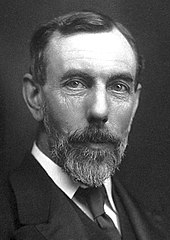Krypton
![]()
This article is about the chemical element. For other meanings, see Krypton (disambiguation).
Krypton (ancient Greek κρυπτός kryptós "hidden") is a chemical element with the element symbol Kr and atomic number 36. In the periodic table it is in the 8th main group, i.e. the 18th IUPAC group, and therefore belongs to the noble gases. Like the other noble gases, it is a colorless, extremely inert, monatomic gas. In many properties, such as melting and boiling point or density, it stands between the lighter argon and the heavier xenon.
Krypton is one of the rarest elements on earth and only occurs in small quantities in the atmosphere.
The noble gas was discovered in 1898 by William Ramsay and Morris William Travers by fractional distillation of liquid air. Due to its rarity, krypton is used only in small quantities, mainly as a filler gas for incandescent lamps. A small number of krypton compounds are known, of which krypton difluoride is one of the strongest oxidizing agents known.
History
In 1894 argon had been discovered as the first noble gas by John William Strutt, 3rd Baron Rayleigh and William Ramsay, one year later helium, known so far only from the solar spectrum, was isolated by Ramsay from uranium ores. From the laws of the periodic table, Ramsay realized that there must be other such elements. Therefore, starting in 1896, he first investigated various minerals and meteorites and the gases they emitted when heated or dissolved. However, he and his colleague Morris William Travers were not successful, only helium and, more rarely, argon were found. The investigation of hot gases from Cauterets in France and from Iceland also brought no results.
Finally, they examined 15 litres of liquefied crude argon and separated it by fractional distillation. In the residue they found hitherto unknown yellow and green spectral lines, i.e. a new element. It was named krypton after the ancient Greek κρυπτός kryptós ("hidden"). After purification by further distillation, Ramsay and Travers were also able to determine its molar mass of about 80 g/mol. After this discovery, they found the element neon in another, lower-boiling fraction, and finally, by separating the crude krypton, the element xenon.
In 1924, Andreas von Antropoff claimed to have synthesized a first krypton compound in the form of a red stable solid of krypton and chlorine. However, it later turned out that this compound did not contain krypton, but nitrogen monoxide and hydrogen chloride. Greater efforts in the synthesis of krypton compounds were made after the discovery of the first xenon compounds in 1962. Aristid von Grosse was the first to present a krypton compound. He initially thought it was krypton tetrafluoride; however, it was identified as krypton difluoride after further experiments.
The wavelength of an electromagnetic radiation emitted by the krypton isotope 86Kr was chosen as the basis for the definition of the metre in 1960. It thus replaced the too imprecise definition via the primal meter made of a platinum-iridium alloy. A metre was defined as 1,650,763.73 times the wavelength of the radiation emitted by the nuclide 86Kr during the transition from the 5d5 to the 2pl0 state and propagating in vacuum. In 1983, this definition was finally replaced by one based on the distance light travels in vacuum in a given fraction of a second.

Sir William Ramsay
Occurrence
Krypton is one of the rarest elements on earth. Rarer are only xenon and radioactive elements, which either have already decayed for the most part like plutonium or only occur as a short-lived intermediate product of decay series. The proportion of krypton in the Earth's atmosphere is 1.9 - 10-5 ppm, the largest part of the gas is in the atmosphere, which consists of 1.14 ppm krypton.
In the rest of the universe, krypton occurs in higher proportions, comparable to those of lithium, gallium, and scandium. The ratio of krypton to hydrogen is largely constant in the universe. It can be concluded that interstellar matter is rich in krypton. Krypton could also be detected in a white dwarf. Compared to the Sun, 450 times the amount was measured, but the reason for this high krypton content is still unknown.
Search within the encyclopedia